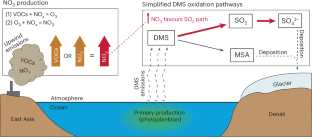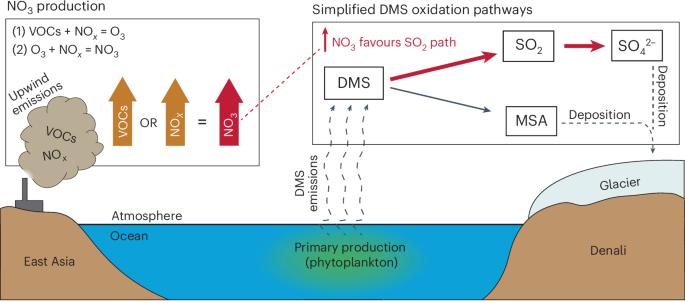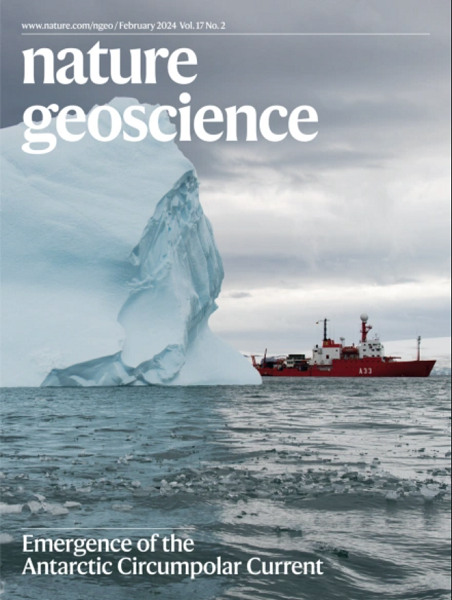Pollution drives multidecadal decline in subarctic methanesulfonic acid
IF 15.7
1区 地球科学
Q1 GEOSCIENCES, MULTIDISCIPLINARY
引用次数: 0
Abstract
An industrial-era decline in Greenland ice-core methanesulfonic acid is thought to herald a collapse in North Atlantic marine phytoplankton stocks related to a weakening of the Atlantic meridional overturning circulation. By contrast, stable levels of total marine biogenic sulfur contradict this interpretation and point to changes in atmospheric oxidation as a potential cause of the methanesulfonic acid decline. However, the impact of oxidation on methanesulfonic acid production has not been quantified, nor has this hypothesis been rigorously tested. Here we present a multi-century methanesulfonic acid record from the Denali, Alaska, ice core, which shows a methanesulfonic acid decline similar in magnitude but delayed by 93 years relative to the Greenland record. Box-model results using updated dimethyl sulfide oxidation pathways indicate that oxidation by pollution-driven nitrate radicals has suppressed atmospheric methanesulfonic acid production, explaining most, if not all, of Denali’s and Greenland’s methanesulfonic acid declines without requiring a change in phytoplankton production. The delayed timing of the North Pacific methanesulfonic acid decline, relative to the North Atlantic, reflects the distinct history of industrialization in upwind regions and is consistent with the Denali and Greenland ice-core nitrate records. These results demonstrate that multidecadal trends in industrial-era Arctic ice-core methanesulfonic acid reflect rising anthropogenic pollution rather than declining marine primary production. Multidecadal declines in methanesulfonic acid in arctic ice cores reflect increasing anthropogenic pollution in the industrial era rather than declining marine primary production, according to analyses of a multi-century record of methanesulfonic acid from Alaska and atmospheric modelling.


污染导致亚北极甲烷磺酸出现十年一遇的下降
工业时代格陵兰冰芯甲烷磺酸的下降被认为预示着与大西洋经向翻转环流减弱有关的北大西洋海洋浮游植物种群的崩溃。相比之下,海洋生物源硫总量的稳定水平与这一解释相矛盾,并指出大气氧化作用的变化是甲烷磺酸下降的潜在原因。然而,氧化作用对甲烷磺酸产量的影响尚未量化,这一假设也未得到严格验证。在这里,我们展示了来自阿拉斯加德纳利冰芯的多世纪甲烷磺酸记录,该记录显示甲烷磺酸的下降幅度与格陵兰记录相似,但相对于格陵兰记录延迟了 93 年。使用更新的二甲基硫醚氧化途径的盒式模型结果表明,污染驱动的硝酸自由基氧化抑制了大气中甲烷磺酸的生成,从而解释了德纳利和格陵兰岛甲烷磺酸下降的大部分原因(如果不是全部原因的话),而无需改变浮游植物的产量。与北大西洋相比,北太平洋甲烷磺酸下降的时间推迟,这反映了上风地区独特的工业化历史,并与德纳利和格陵兰冰芯的硝酸盐记录相一致。这些结果表明,工业时代北极冰芯甲烷磺酸的十年趋势反映了人为污染的加剧,而不是海洋初级生产的下降。
本文章由计算机程序翻译,如有差异,请以英文原文为准。
求助全文
约1分钟内获得全文
求助全文
来源期刊

Nature Geoscience
地学-地球科学综合
CiteScore
26.70
自引率
1.60%
发文量
187
审稿时长
3.3 months
期刊介绍:
Nature Geoscience is a monthly interdisciplinary journal that gathers top-tier research spanning Earth Sciences and related fields.
The journal covers all geoscience disciplines, including fieldwork, modeling, and theoretical studies.
Topics include atmospheric science, biogeochemistry, climate science, geobiology, geochemistry, geoinformatics, remote sensing, geology, geomagnetism, paleomagnetism, geomorphology, geophysics, glaciology, hydrology, limnology, mineralogy, oceanography, paleontology, paleoclimatology, paleoceanography, petrology, planetary science, seismology, space physics, tectonics, and volcanology.
Nature Geoscience upholds its commitment to publishing significant, high-quality Earth Sciences research through fair, rapid, and rigorous peer review, overseen by a team of full-time professional editors.
 求助内容:
求助内容: 应助结果提醒方式:
应助结果提醒方式:


